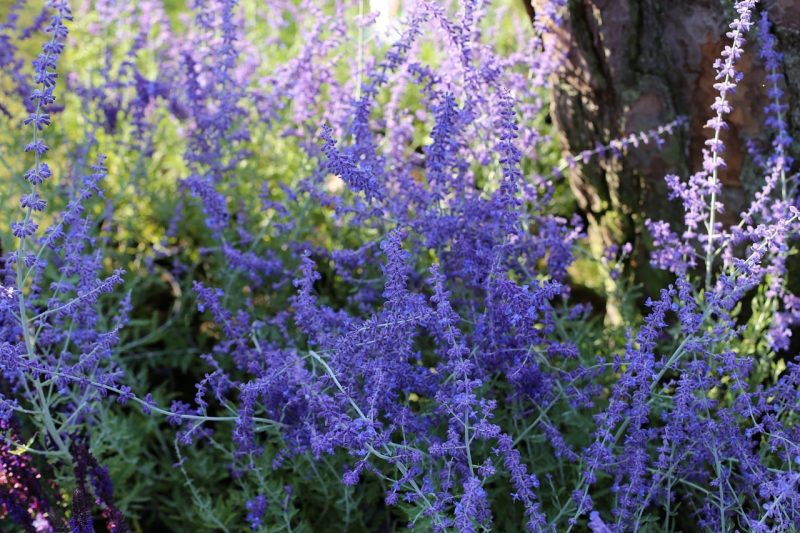Learning how to propagate Russian sage is easy, and you have three options to choose from. This perennial can satisfy those who want to have something low maintenance but still add color to the garden. And because you have three propagation methods, you can select the technique that works well for your situation.
While Russian sage is generally hardy and will thrive well from growing zones 5 to 9, you can also consider growing it in the greenhouse. Among the extensive list of plants that you can grow indoors, this flowering perennial will surely benefit from stable conditions. Remember that with propagation, you want to provide the ideal environment to encourage the germination of seeds or establish the cuttings and divisions.

How To Propagate Russian Sage For Beginners
Option #1. Seeds
According to the University of Wisconsin, the best time to sow Russian sage seeds is any time of the year. You will even benefit more from using a greenhouse because you protect the seeds from extreme climate and temperatures. This is why, while the university mentioned the flexibility of the sowing time of this plant, you still need to cover them with the medium.
You can buy Russian sage seeds, but you can also collect them from your plants. You’ll wait at the end of the flowering cycle and cut off the pods intact. You can then store the seeds in an airtight container until use.
Cold stratification and germination
Propagating Russian sage from seeds is not a favorite among gardeners because the germination can take anywhere between one to four months. However, you may have no plants to source cuttings from, so it’s useful to know how to start Russian sage from seeds. More so, the seeds require cold stratification to break them off dormancy and produce a healthy and compact plant.
To treat the seeds before germination, place them in an area with temperatures between 35 to 44°F for ten days or more. Another method is to put them in a plastic bag and into the refrigerator for a month to increase the sprouting rate and germination. And for the sprouting itself, maintain the greenhouse around 60 to 65°F to encourage germination.
Sowing and transplanting
Sow the seeds in potting soil and maintain moisture. Once the seedlings are large enough, you can transplant them in another container and wait until you can transplant in late spring. However, remember to harden the plants first to avoid stress.
Option #2. Cuttings
The second and perhaps the best option to propagate Russian sage is by cuttings. It takes a shorter time to grow the plants from cuttings, and you don’t need to do a treatment to get them rooting. With this method, you can take cuttings in early summer or late spring.
Gathering
Make sure to select a healthy plant and gather softwood cuttings around 4 inches long. The greenhouse is also beneficial for this method because it can grow healthy parent plants that can endure the cuttings. Once you have the cuttings, you want to remove all the leaves at the end and dip it in the rooting hormone powder.
Planting
Dip the cutting in a loose and moist potting soil and compact the soil around it to keep it stable. The cuttings should root well if you keep it somewhere bright but out of direct sunlight. You must also maintain soil moisture to encourage the establishment and protect the cuttings from wind and high temperatures.
Option #3. Division
The final option for Russian sage propagation is by division. This is best for those with older plants because you can do it every three years for maintenance and a chance to clone more plants. The best time to do so is spring or fall when the Russian sage plants are not actively blooming, with distinguishable dry buds.
Digging
To divide, cut down the plant to 8 inches to make digging easier. You can then use a shovel and dig around the plant so you can get the whole rootball. And once you have dug out the plant, remove the soil on the rootball to make the division more comfortable.
Planting
The sections you can produce will depend on how big the plant. Use your hands to separate the roots and place the sections in water to keep them moist. Starting divisions in the greenhouse will also give you a headstart because the environment is stable.
The new hole for these transplants should be as deep as the length of the roots. You also want to stabilize the plant, especially around its roots when planting. Use fertile soil and ensure moisture as you would with the previous propagation techniques.
Conclusion
Low maintenance plants like Russian sage will surely add color to your garden or greenhouse. And best of all, learning how to propagate Russian sage is even simple and gives you many options to choose from. If you don’t have adult plants yet, you can sow Russian sage, given that you have stratified them first.
On the other hand, you can take cuttings in early summer or late spring from your existing plants. Those who want to maintain Russian sage can also divide every three years and produce more plants by digging one plant and planting the new sections. Whichever method you choose, you will have a higher success rate in maintaining the ideal growing conditions using a greenhouse.
